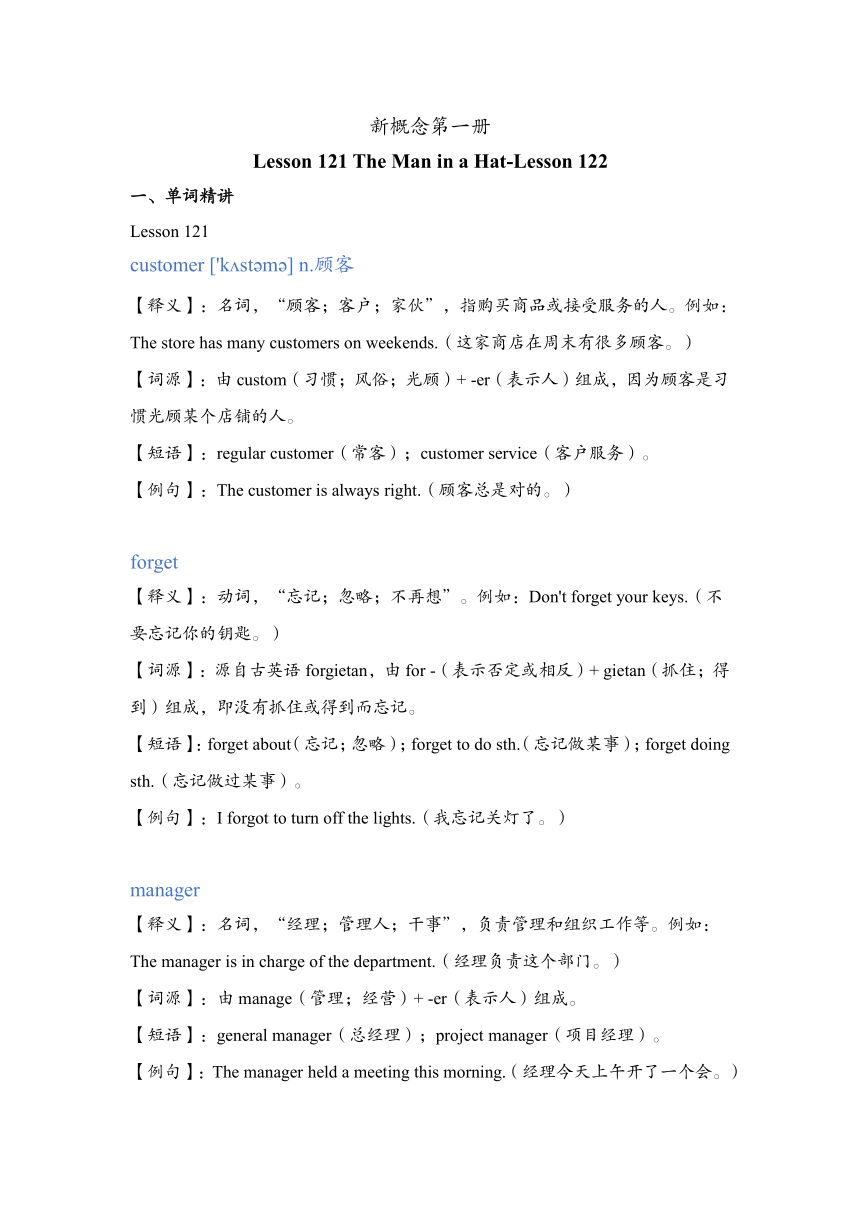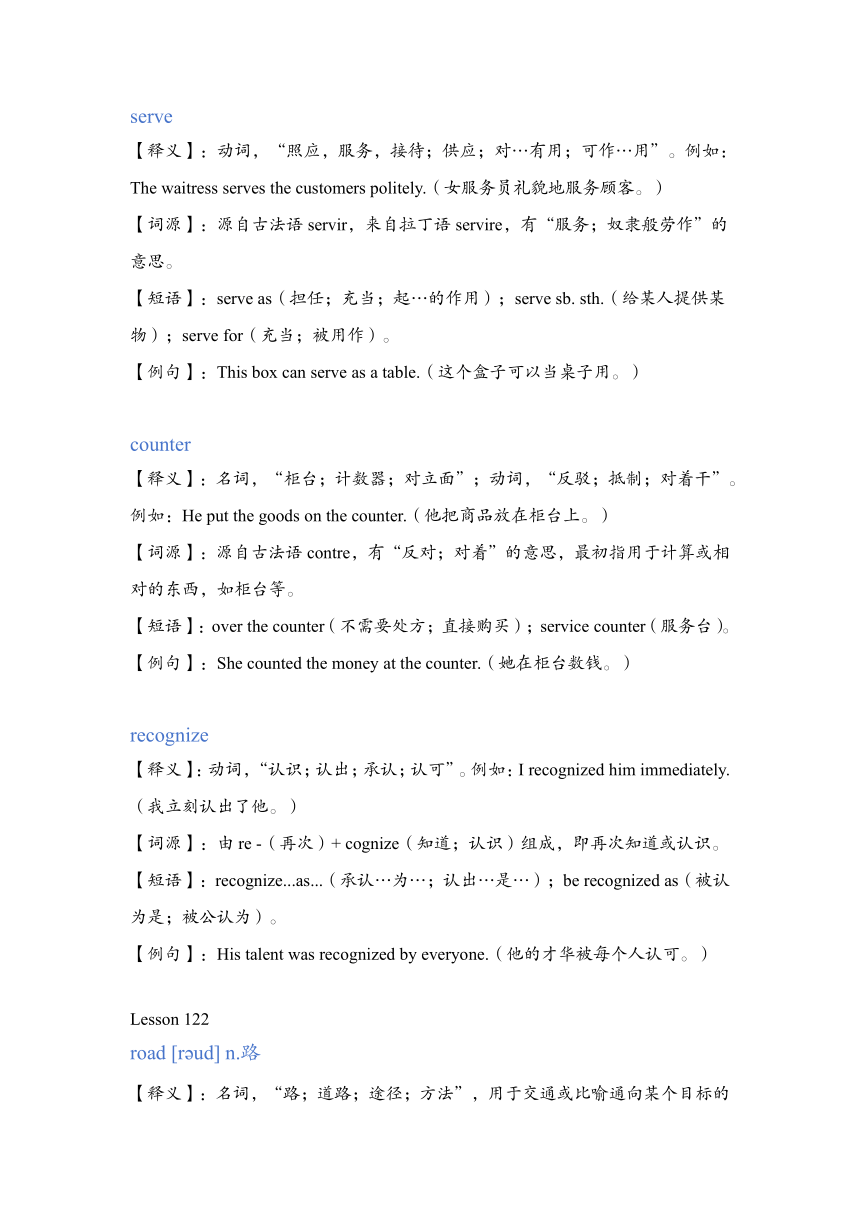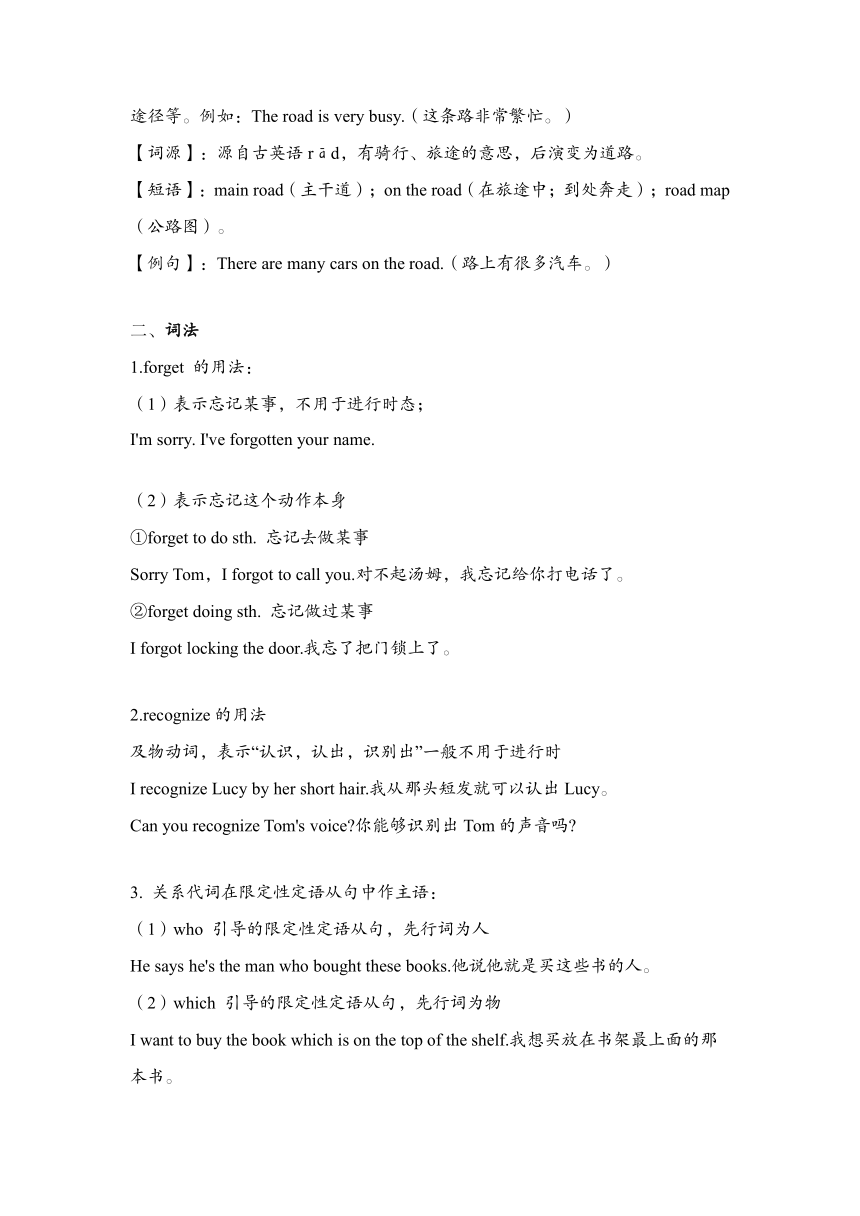新概念第一册Lesson 121 The Man in a Hat-Lesson 122讲义
文档属性
| 名称 | 新概念第一册Lesson 121 The Man in a Hat-Lesson 122讲义 |  | |
| 格式 | docx | ||
| 文件大小 | 122.4KB | ||
| 资源类型 | 教案 | ||
| 版本资源 | 新概念英语 | ||
| 科目 | 英语 | ||
| 更新时间 | 2024-12-04 08:42:58 | ||
图片预览



文档简介
新概念第一册
Lesson 121 The Man in a Hat-Lesson 122
单词精讲
Lesson 121
customer ['k st m ] n.顾客
【释义】:名词,“顾客;客户;家伙”,指购买商品或接受服务的人。例如:The store has many customers on weekends.(这家商店在周末有很多顾客。)
【词源】:由custom(习惯;风俗;光顾)+ -er(表示人)组成,因为顾客是习惯光顾某个店铺的人。
【短语】:regular customer(常客);customer service(客户服务)。
【例句】:The customer is always right.(顾客总是对的。)
forget
【释义】:动词,“忘记;忽略;不再想”。例如:Don't forget your keys.(不要忘记你的钥匙。)
【词源】:源自古英语forgietan,由for -(表示否定或相反)+ gietan(抓住;得到)组成,即没有抓住或得到而忘记。
【短语】:forget about(忘记;忽略);forget to do sth.(忘记做某事);forget doing sth.(忘记做过某事)。
【例句】:I forgot to turn off the lights.(我忘记关灯了。)
manager
【释义】:名词,“经理;管理人;干事”,负责管理和组织工作等。例如:The manager is in charge of the department.(经理负责这个部门。)
【词源】:由manage(管理;经营)+ -er(表示人)组成。
【短语】:general manager(总经理);project manager(项目经理)。
【例句】:The manager held a meeting this morning.(经理今天上午开了一个会。)
serve
【释义】:动词,“照应,服务,接待;供应;对…有用;可作…用”。例如:The waitress serves the customers politely.(女服务员礼貌地服务顾客。)
【词源】:源自古法语servir,来自拉丁语servire,有“服务;奴隶般劳作”的意思。
【短语】:serve as(担任;充当;起…的作用);serve sb. sth.(给某人提供某物);serve for(充当;被用作)。
【例句】:This box can serve as a table.(这个盒子可以当桌子用。)
counter
【释义】:名词,“柜台;计数器;对立面”;动词,“反驳;抵制;对着干”。例如:He put the goods on the counter.(他把商品放在柜台上。)
【词源】:源自古法语contre,有“反对;对着”的意思,最初指用于计算或相对的东西,如柜台等。
【短语】:over the counter(不需要处方;直接购买);service counter(服务台)。
【例句】:She counted the money at the counter.(她在柜台数钱。)
recognize
【释义】:动词,“认识;认出;承认;认可”。例如:I recognized him immediately.(我立刻认出了他。)
【词源】:由re -(再次)+ cognize(知道;认识)组成,即再次知道或认识。
【短语】:recognize...as...(承认…为…;认出…是…);be recognized as(被认为是;被公认为)。
【例句】:His talent was recognized by everyone.(他的才华被每个人认可。)
Lesson 122
road [r ud] n.路
【释义】:名词,“路;道路;途径;方法”,用于交通或比喻通向某个目标的途径等。例如:The road is very busy.(这条路非常繁忙。)
【词源】:源自古英语rād,有骑行、旅途的意思,后演变为道路。
【短语】:main road(主干道);on the road(在旅途中;到处奔走);road map(公路图)。
【例句】:There are many cars on the road.(路上有很多汽车。)
词法
1.forget 的用法:
(1)表示忘记某事,不用于进行时态;
I'm sorry. I've forgotten your name.
(2)表示忘记这个动作本身
①forget to do sth. 忘记去做某事
Sorry Tom,I forgot to call you.对不起汤姆,我忘记给你打电话了。
②forget doing sth. 忘记做过某事
I forgot locking the door.我忘了把门锁上了。
2.recognize的用法
及物动词,表示“认识,认出,识别出”一般不用于进行时
I recognize Lucy by her short hair.我从那头短发就可以认出Lucy。
Can you recognize Tom's voice 你能够识别出Tom的声音吗
3. 关系代词在限定性定语从句中作主语:
(1)who 引导的限定性定语从句,先行词为人
He says he's the man who bought these books.他说他就是买这些书的人。
(2)which 引导的限定性定语从句,先行词为物
I want to buy the book which is on the top of the shelf.我想买放在书架最上面的那本书。
(3)that 引导的限定性定语从句,先行词为人/物
I want to buy the book that is on the top of the shelf.
He says he's the man that bought these books.
4. 关系代词在限定性定语从句中作宾语:
能在限定性定语从句中作宾语的关系代词有 whom,which 和 that,作宾语的关系代词通常都可以省略
The man (who/whom/that) I served was wearing a hat.我服务的那个人是戴着帽子的。
5. 含有定语从句的一般疑问句
直接将 be 动词前提至句首:
Is this the man that/who/whom you served
6.1、表示“路”的词义辨析:
(1)road 道路
指城镇或乡村间可供车辆行人通过的宽阔平坦的大路,路两边有无建筑物均可
(2)street 街道
指两边有房屋或者是商店的街道或马路
(3)avenue 大道,大街 缩写 ave.
指宽阔并且繁华的林荫大道
重点句型
1.定语
定语是用来修饰名词或代词的品质与特征的,可以做定语的词主要有形容词、名词等等。
a beautiful flower,定语 beautiful 修饰名词 flower
2.定语从句
(1)在一个复合句当中,如果用一个句子作为定语来修饰某一个名词或代词,那么这个句子就叫做定语从句。
I met a girl who is very beautiful.我遇到了一个非常漂亮的女孩。
The lady who is standing behind the counter served me.站在柜台后面的那位女士给我服务.
(2)定语从句的结构:先行词 + 关系代词 + 定语从句
先行词:被修饰的名词或代词
关系代词:who 用于人,which 用于物,that 既可以用于人,也可以用于物
who用于人
The lady who is standing behind the counter served me.站在柜台后的那位女土接待了我。
which用于物
I forgot to bring the book which you bought me last year.我忘记把去年你买给我的那本书带来了。
that既可用于人,也可用于物
用于人:The lady that is standing behind the counter served me.站在柜台后的那位女士接待了我。
用于物:I forgot to bring the book that you bought me last year.我忘记把去年你买给我的那本书带来了。
3. 关系代词在限定性定语从句中作主语:
(1)who 引导的限定性定语从句,先行词为人
He says he's the man who bought these books.
(2)which 引导的限定性定语从句,先行词为物
I want to buy the book which is on the top of the shelf.
(3)that 引导的限定性定语从句,先行词为人/物
I want to buy the book that is on the top of the shelf.
He says he's the man that bought these books.
4. 关系代词在限定性定语从句中作宾语:
能在限定性定语从句中作宾语的关系代词有 whom,which 和 that,作宾语的关系代词通常都可以省略
The man who / whom / that I served was wearing a hat.
5 定语从句中的主谓一致性原则:
be 动词和先行词(主句的主语)相呼应
The men who are repairing the road are making all that noise.
四、课文精讲
1.…but I forgot to take them with me.……但是我忘了拿走。
forget to do sth.表示“忘了做某事”,them指两本字典。
2.put it on,戴上它。
这里的 it指 a hat,以避免重复。put on是“戴上”、“穿上”的意思。如果它的宾语是一个名词,这个名词可放在 put on之后,也可放在put和on之间。如果是代词,就必须放在put和on 之间。如:
Put on your coat./Put your coat on.穿上外衣。
但只能说:Put it on.把它穿上。
Lesson 121 The Man in a Hat-Lesson 122
单词精讲
Lesson 121
customer ['k st m ] n.顾客
【释义】:名词,“顾客;客户;家伙”,指购买商品或接受服务的人。例如:The store has many customers on weekends.(这家商店在周末有很多顾客。)
【词源】:由custom(习惯;风俗;光顾)+ -er(表示人)组成,因为顾客是习惯光顾某个店铺的人。
【短语】:regular customer(常客);customer service(客户服务)。
【例句】:The customer is always right.(顾客总是对的。)
forget
【释义】:动词,“忘记;忽略;不再想”。例如:Don't forget your keys.(不要忘记你的钥匙。)
【词源】:源自古英语forgietan,由for -(表示否定或相反)+ gietan(抓住;得到)组成,即没有抓住或得到而忘记。
【短语】:forget about(忘记;忽略);forget to do sth.(忘记做某事);forget doing sth.(忘记做过某事)。
【例句】:I forgot to turn off the lights.(我忘记关灯了。)
manager
【释义】:名词,“经理;管理人;干事”,负责管理和组织工作等。例如:The manager is in charge of the department.(经理负责这个部门。)
【词源】:由manage(管理;经营)+ -er(表示人)组成。
【短语】:general manager(总经理);project manager(项目经理)。
【例句】:The manager held a meeting this morning.(经理今天上午开了一个会。)
serve
【释义】:动词,“照应,服务,接待;供应;对…有用;可作…用”。例如:The waitress serves the customers politely.(女服务员礼貌地服务顾客。)
【词源】:源自古法语servir,来自拉丁语servire,有“服务;奴隶般劳作”的意思。
【短语】:serve as(担任;充当;起…的作用);serve sb. sth.(给某人提供某物);serve for(充当;被用作)。
【例句】:This box can serve as a table.(这个盒子可以当桌子用。)
counter
【释义】:名词,“柜台;计数器;对立面”;动词,“反驳;抵制;对着干”。例如:He put the goods on the counter.(他把商品放在柜台上。)
【词源】:源自古法语contre,有“反对;对着”的意思,最初指用于计算或相对的东西,如柜台等。
【短语】:over the counter(不需要处方;直接购买);service counter(服务台)。
【例句】:She counted the money at the counter.(她在柜台数钱。)
recognize
【释义】:动词,“认识;认出;承认;认可”。例如:I recognized him immediately.(我立刻认出了他。)
【词源】:由re -(再次)+ cognize(知道;认识)组成,即再次知道或认识。
【短语】:recognize...as...(承认…为…;认出…是…);be recognized as(被认为是;被公认为)。
【例句】:His talent was recognized by everyone.(他的才华被每个人认可。)
Lesson 122
road [r ud] n.路
【释义】:名词,“路;道路;途径;方法”,用于交通或比喻通向某个目标的途径等。例如:The road is very busy.(这条路非常繁忙。)
【词源】:源自古英语rād,有骑行、旅途的意思,后演变为道路。
【短语】:main road(主干道);on the road(在旅途中;到处奔走);road map(公路图)。
【例句】:There are many cars on the road.(路上有很多汽车。)
词法
1.forget 的用法:
(1)表示忘记某事,不用于进行时态;
I'm sorry. I've forgotten your name.
(2)表示忘记这个动作本身
①forget to do sth. 忘记去做某事
Sorry Tom,I forgot to call you.对不起汤姆,我忘记给你打电话了。
②forget doing sth. 忘记做过某事
I forgot locking the door.我忘了把门锁上了。
2.recognize的用法
及物动词,表示“认识,认出,识别出”一般不用于进行时
I recognize Lucy by her short hair.我从那头短发就可以认出Lucy。
Can you recognize Tom's voice 你能够识别出Tom的声音吗
3. 关系代词在限定性定语从句中作主语:
(1)who 引导的限定性定语从句,先行词为人
He says he's the man who bought these books.他说他就是买这些书的人。
(2)which 引导的限定性定语从句,先行词为物
I want to buy the book which is on the top of the shelf.我想买放在书架最上面的那本书。
(3)that 引导的限定性定语从句,先行词为人/物
I want to buy the book that is on the top of the shelf.
He says he's the man that bought these books.
4. 关系代词在限定性定语从句中作宾语:
能在限定性定语从句中作宾语的关系代词有 whom,which 和 that,作宾语的关系代词通常都可以省略
The man (who/whom/that) I served was wearing a hat.我服务的那个人是戴着帽子的。
5. 含有定语从句的一般疑问句
直接将 be 动词前提至句首:
Is this the man that/who/whom you served
6.1、表示“路”的词义辨析:
(1)road 道路
指城镇或乡村间可供车辆行人通过的宽阔平坦的大路,路两边有无建筑物均可
(2)street 街道
指两边有房屋或者是商店的街道或马路
(3)avenue 大道,大街 缩写 ave.
指宽阔并且繁华的林荫大道
重点句型
1.定语
定语是用来修饰名词或代词的品质与特征的,可以做定语的词主要有形容词、名词等等。
a beautiful flower,定语 beautiful 修饰名词 flower
2.定语从句
(1)在一个复合句当中,如果用一个句子作为定语来修饰某一个名词或代词,那么这个句子就叫做定语从句。
I met a girl who is very beautiful.我遇到了一个非常漂亮的女孩。
The lady who is standing behind the counter served me.站在柜台后面的那位女士给我服务.
(2)定语从句的结构:先行词 + 关系代词 + 定语从句
先行词:被修饰的名词或代词
关系代词:who 用于人,which 用于物,that 既可以用于人,也可以用于物
who用于人
The lady who is standing behind the counter served me.站在柜台后的那位女土接待了我。
which用于物
I forgot to bring the book which you bought me last year.我忘记把去年你买给我的那本书带来了。
that既可用于人,也可用于物
用于人:The lady that is standing behind the counter served me.站在柜台后的那位女士接待了我。
用于物:I forgot to bring the book that you bought me last year.我忘记把去年你买给我的那本书带来了。
3. 关系代词在限定性定语从句中作主语:
(1)who 引导的限定性定语从句,先行词为人
He says he's the man who bought these books.
(2)which 引导的限定性定语从句,先行词为物
I want to buy the book which is on the top of the shelf.
(3)that 引导的限定性定语从句,先行词为人/物
I want to buy the book that is on the top of the shelf.
He says he's the man that bought these books.
4. 关系代词在限定性定语从句中作宾语:
能在限定性定语从句中作宾语的关系代词有 whom,which 和 that,作宾语的关系代词通常都可以省略
The man who / whom / that I served was wearing a hat.
5 定语从句中的主谓一致性原则:
be 动词和先行词(主句的主语)相呼应
The men who are repairing the road are making all that noise.
四、课文精讲
1.…but I forgot to take them with me.……但是我忘了拿走。
forget to do sth.表示“忘了做某事”,them指两本字典。
2.put it on,戴上它。
这里的 it指 a hat,以避免重复。put on是“戴上”、“穿上”的意思。如果它的宾语是一个名词,这个名词可放在 put on之后,也可放在put和on之间。如果是代词,就必须放在put和on 之间。如:
Put on your coat./Put your coat on.穿上外衣。
但只能说:Put it on.把它穿上。
同课章节目录
